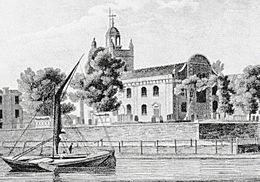All Saints' Church, Isleworth facts for kids
Quick facts for kids All Saints' Church |
|
|---|---|

All Saints in the early 19th century
|
|
| 51°28′18″N 0°19′11″W / 51.4717°N 0.3198°W | |
| Location | Isleworth |
| Country | United Kingdom |
| Denomination | Church of England |
| Previous denomination | Roman Catholicism |
| Architecture | |
| Heritage designation | Grade II* |
| Designated | 15 June 1951 |
All Saints' Church is the oldest church in Isleworth, a town in southwest London. It is a very old and important building in the area.
Contents
A Look at All Saints' Church History
Only its old 14th-century stone tower and foundations are left from before the 1900s. The church stands near the River Thames, close to Syon Park. The church's area, called a parish, has been around since before the Norman Conquest in 1066!
Early Days of the Church
Records from 1290 mention a vicar (a type of church leader) who replaced the rector. This vicar was connected to Syon Abbey. The abbey gave him money, new clothes, and food every day. His servant also received meals. Later, after the dissolution of the monasteries (when many religious buildings were closed), the church's ownership went to the trustees of St George's Chapel, Windsor.
Rebuilding and New Designs
By the late 1600s, the church building was in bad shape. Famous architect Sir Christopher Wren was asked to draw plans for a new church. His ideas were too expensive at first. But in 1705, a man named Sir Orlando Gee left £500 in his will to help with the work. This money, along with other donations, allowed the rebuilding to happen in 1705–1706. Sir Orlando Gee is remembered with a special marble monument by Francis Bird.
Fire and Modern Reconstruction
From 1760 to 1790, a music expert named Marmaduke Overend was the church's organist. In 1943, a big fire badly damaged the church. The fire was started by two boys. After the fire, the inside of the church had to be completely rebuilt.
The current inner part of the church was built in 1970. The architect was Michael Blee, who also designed parts of Douai Abbey. The beautiful stained-glass windows were created by Keith New. The original 15th-century stone tower was kept. In 1973, the church won a Civic Trust award for its design. It is also a Grade II* listed building, which means it is a very important historical site.

